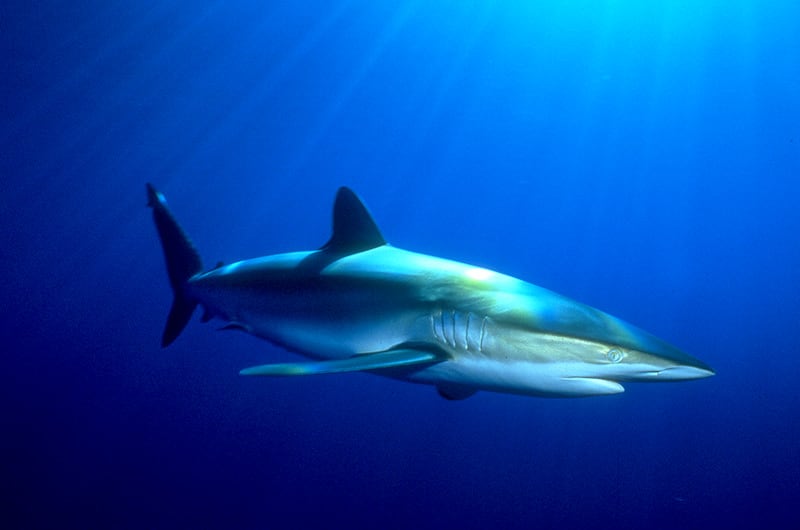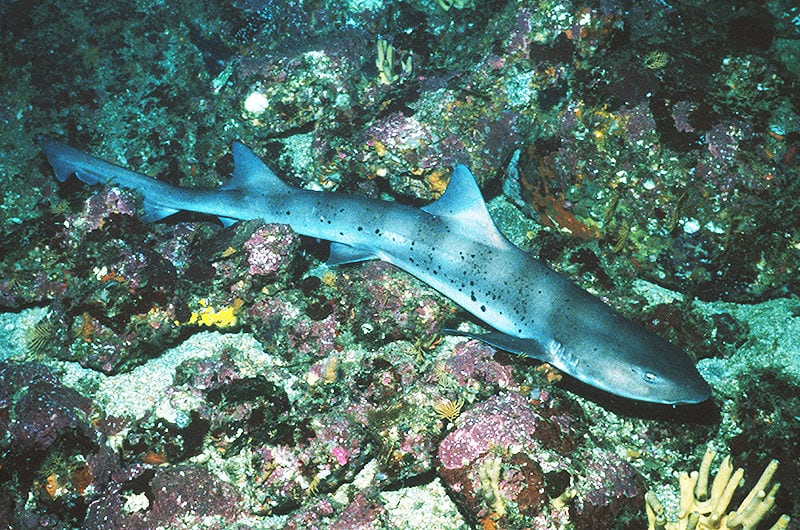Photo © Alexa Elliot
Photo © Alexa Elliot
Photo © Alexa Elliot

Typical species:
Silky shark
Photo © BluePlanetArchive.com
Families:
8
Genera:
52
Species:
294
Ground sharks
The order of the ground sharks consists of 8 families with more than 270 species. More than half of all known shark species are ground sharks.This order also represents the most typical sharks.
Their distinguishing features are a nicitating membrane (a flap of skin that functions as a third eye lid), 2 dorsal fins, an anal fin and five gill slits.
Most of these sharks are found in tropical and temperate waters.
Ground sharks possess all forms of reproduction such as oviparity, aplacental viviparity (ovoviviparity) and viviparity.

Typical species:
Small-spotted catshark
Photo © BluePlanetArchive.com
Catsharks
This is an extensive family, consisting of 15 genera including 89 species. Catsharks got their name from their cat-like eyes and have only rudimentary developed nicitating eyelids. They possess moderately large spiracles. The first dorsal fin is smaller than the anal fin, and its origin is slightly before or after the origin of the pelvic fins. Catsharks have a world-wide distribution from tropical to cold-temperate waters over the continental shelves to the slopes down to 2000 m . Catsharks normally feed on invertebrates and small fishes, and most of them lay eggs (oviparous). The biology of most species is poorly known.

Typical species:
Great hammerhead
Photo © Shutterstock
Hammerhead sharks
This is the most easily recognised family. All 9 species have laterally expanded blades (hammer-like) on their heads, with circular eyes and internal nicitating eyelids on the outermost edges of their blades. All hammerhead sharks have relatively small pectoral fins due to these blades. The origin of the first dorsal fin is above or slightly behind the base of the pectoral fins. Precaudal pits are present. Hammerhead sharks show a wide distribution in warm-temperate and tropical waters, mainly over the continental shelves down to about 270 m. No species is truly oceanic. Their uniquely shaped head gives them many advantages regarding sensory organs and maneuverability. Hammerhead sharks give birth to living young (placental viviparity).
Finback catsharks
Finback catsharks are similar in appearance to the catsharks, however the origin of their first dorsal fin is right behind the base of the pectoral fins. This family consists of 4 genera and 6 species. The biology of all members of this family is poorly understood. They are mainly found on the outer continental shelves and slopes of tropical to warm waters and are primarily deep water forms, preferring depths between 50 m and 700 m . They feed on invertebrates and small fishes. Oviparous (egg laying) and ovoviviparous (aplacental viviparous) styles of reproduction present.
Weasel sharks
This is a small family consisting of 7 species, divided in 4 genera. With the exception of the snaggletooth shark (Hemipristis elongata) which can reach a size of up to 240 cm, weasel sharks are mostly small to moderate-sized animals with horizontally oriented oval eyes, internal nicitating membranes and spiraculi. Weasel sharks are close related to the requiem sharks (Carcharhinidae) and have similar features. The origin of the first dorsal fin is close to the pectoral fin bases. A precaudal pit is present. They are found in coastal tropical areas down to 100 m. Their distribution is limited to the Atlantic and continental Indo-West Pacific. They feed on a variety of small fishes, crustaceans and echinoderms. They all give birth to live young (placental viviparity).
Barbelled houndsharks
This is another family with only one species, the barbeled houndshark, Leptocharias smithii. This very slender and relatively small species has two equal-sized dorsal fins. Its horizontally oval eyes have internal nicitating eyelids. Barbeled houndsharks have slender barbels. They are found only in the Eastern Atlantic, from Mauritania down to Angola and possibly north to Morocco and including the Mediterranean Sea. It is a very common species of inshore waters down to a depth of approximately 75m. They can be found around river mouths, and prefer muddy bottoms. Barbeled houndsharks feed on fishes and crustaceans. They possess a dental sexual dimorphism where the males have greatly enlarged anterior teeth, possibly used during courtship and copulation. They give birth to live young (placental viviparity).
False catsharks
A family consisting of only one species, the false catshark (Pseudotriakis microdon). This easily distinguished shark has a large but very low first dorsal fin that ends above the origin of the pelvic fins. Its elongated cat-like eyes are have nicitating eyelids and large spiracles. The body is very soft. This species shows a wide distribution, mostly in the Northern hemisphere, including the Atlantic, Pacific and Indian Oceans over the continental shelves and slopes down to 1500 m . False catsharks are bottom-dwelling species. The biology of this species is not well studied but its soft body suggests a relatively inactive, sluggish lifestyle. The feeding habits are not well known but it seems that this species feeds on fishes. False catsharks can reach sizes up to 3m with an ovoviviparous (aplacental viviparous) style of reproduction.

Typical species:
Silvertip shark
Photo © BluePlanetArchive.com
Requiem sharks
This family represents the most typical forms of sharks. It is one of the bigger families with 12 genera consisting of 48 species, with 29 of them belonging to the genus Carcharhinus. Taxonomic features have to be used to differentiate between many of these similar species. Requiem sharks have circular, round eyes, internal nicitating eyelids (nicitating membranes) and usually no spiracle. The first dorsal fin is normally moderate-sized to large with its origin mostly close to or even above the pectoral fins. The second dorsal fin is usually smaller than the first one. Precaudal pits are present. The caudal fin has a strong ventral lobe. Except for the tiger shark (Galeocerdo cuvier) that reproduces aplacental viviparous, all others show placental viviparity.

Typical species:
Banded houndshark
Photo © Jeremy Safford-Deitsch
Houndsharks
Houndsharks are small to moderately sized with horizontally oval eyes, nicitating eyelids and small spiracles. Although their general appearance resembles requiem sharks, they do not have a precaudal pit. The first dorsal fin is closer to the pectoral fins than to the pelvic fins. The family of houndsharks is one of the larger shark families with 9 genera and 34 species, most of which are found in tropical and temperate coastal areas over the continental shelves. Some of the species have a depth range down to 2000 m but none of them is oceanic. Most prefer sandy, muddy or rocky bottoms. They have been seen around river mouths but no species of this family is able to tolerate freshwater for a long periods of time. Some of them swim in schools. Two styles of reproduction can be found in this family: placental and aplacental viviparity (ovoviviparity).